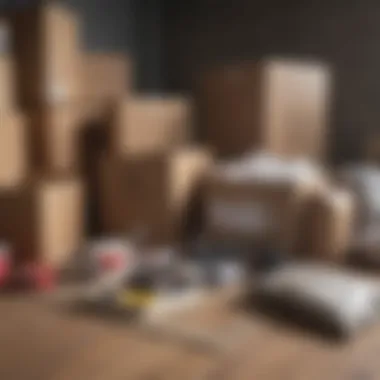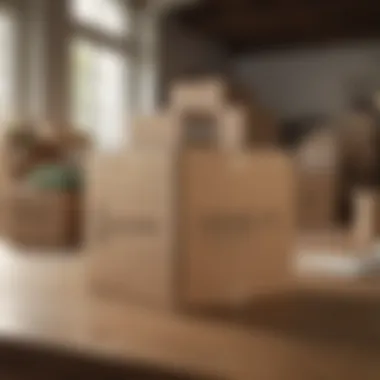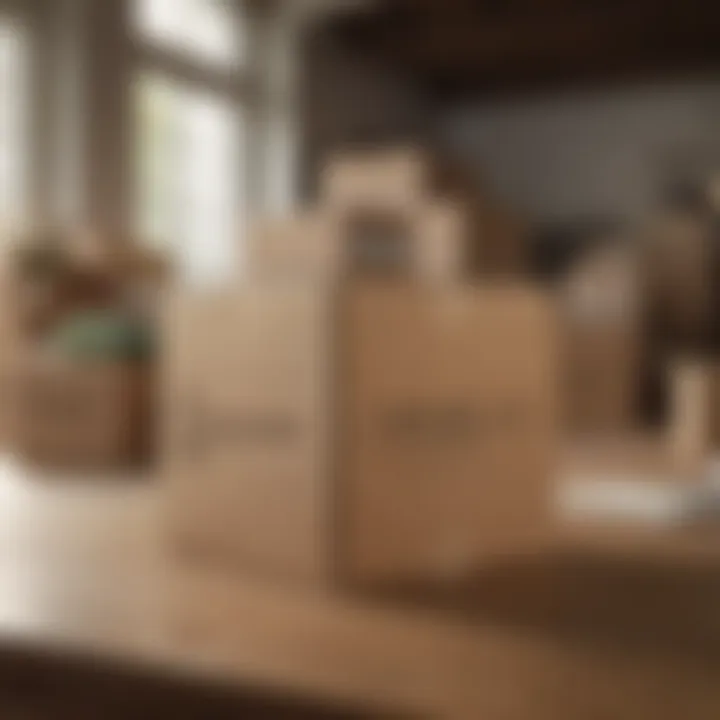Efficient Packing Strategies for a Stress-Free Move


Intro
Packing for a move is a task that can be daunting. The key to a smooth transition lies in understanding the essential strategies that can make this process efficient. Efficient packing not only minimizes stress but also ensures that your belongings arrive at their new destination intact. This article delves into optimal strategies for packing effectively, providing insights tailored for homeowners and individuals invested in preserving their possessions.
Firstly, the importance of organization cannot be overstated. A well-thought-out plan will guide every step of the packing process. This includes budgeting time and resources effectively to majorly reduce last-minutes hassles. With proper planning, you can categorize your items and determine the best packing materials to suit your needs.
Furthermore, choosing the right packing techniques plays a crucial role. This involves selecting proper boxes, protective materials, and labeling, which contribute to the overall efficiency of the process. Understanding how to pack the different types of belongings is equally essential. Different strategies also apply to fragile items, bulky furniture, and clothing.
In this guide, readers will find various tips and techniques to enhance their packing experience, making it less overwhelming. The information is organized in a way that reflects various aspects of the packing process, ensuring clarity and ease of use.
Preface to the Packing Process
Packing is a crucial step in the moving process. It lays the foundation for how smoothly your transition will go. Proper packing not only protects your valuables but also contributes significantly to minimizing stress and chaos during a move. The effectiveness of your packing strategy can influence various aspects such as time management, cost efficiency, and even your emotional well-being. If done thoughtfully, it can optimize your moving day and help in settling into your new home seamlessly.
Understanding the Importance of Proper Packing
Proper packing is essential for several reasons. First, it ensures that fragile items are protected from damage. This is particularly important for glassware, electronics, and sentimental items. Using suitable packing materials and techniques can safeguard your belongings from shocks and potential breakages.
Second, efficient packing can save space. When items are packed effectively, you can utilize every available inch in the moving vehicle. This can reduce the number of trips needed, thus minimizing fuel costs and associated time waste. The end goal is to make the journey as efficient as possible.
Lastly, good packing helps in the organization at the new location. When boxes are arranged logically and labeled clearly, the unpacking process becomes far more manageable. This leads to a quicker adjustment period in your new living space.
Common Challenges Faced When Packing
The packing process does come with its challenges. One common issue is overpacking boxes, which can lead to difficulty lifting and may result in damage. Another challenge is deciding what to keep or discard. Many individuals struggle with attachments to items. This can hinder the packing process and add additional stress.
Furthermore, time management is often a problem. People underestimate the amount of time needed for packing, which can lead to hasty and inadequate packing in the end. This only exacerbates the stress of the move.
In summary, acknowledging these common challenges at the outset can help in planning strategies to mitigate them. Preparing for these difficulties allows for a smoother and more organized packing experience.
Establishing a Comprehensive Packing Timeline
Establishing a comprehensive packing timeline is not merely a suggestion; it is a crucial step in the moving process. When packing for a move, time management can reduce anxiety and ensure that nothing is overlooked. By setting a clear timeline, individuals can break down the task into manageable segments. This proactive approach allows for a better organization of tasks and minimizes last-minute chaos.
Timing involves more than just knowing when to start. It requires consideration of the time available before the move, the complexity of the belongings, and the logistics involved, including transportation and unpacking. The earlier this timeline is established, the easier it is to stay on track. Assigning specific days or weeks for particular tasks reduces the likelihood of feeling overwhelmed and increases fulfillment upon completion.
One significant benefit of a well-structured timeline is the ability to prioritize. For instance, valuable items can take longer to pack, and urgent matters such as utility transfers need immediate attention. Clear prioritization ensures everything is handled efficiently while allowing for flexibility if unforeseen issues arise. Managing a timeline also enhances the chance for thoroughness, which ultimately protects items during the move.
A comprehensive timeline is key for an organized move, ensuring you mark tasks effectively.
Creating a Pre-Move Checklist
A pre-move checklist serves as an excellent foundation when establishing a packing timeline. This document outlines all necessary tasks leading up to the move, creating a clear guide that helps maintain focus and organization. A successful pre-move checklist generally includes:
- Sorting belongings: Determine what to keep, donate, or discard.
- Researching moving companies: Review options to find the right fit.
- Scheduling utilities: Arrange disconnection and reconnection dates.
- Notifying change of address: Inform essential contacts and services.
- Gathering packing supplies: Ensure you have boxes, tape, and packing materials ready.
By following a checklist, not only do you guarantee thorough coverage of all tasks, but you also enjoy the satisfaction that accompanies each completed item. This small act can provide mental clarity and boosts motivation.
Setting a Packing Schedule
Setting a packing schedule involves creating specific time blocks dedicated to packing various items or rooms. This well-timed organization is instrumental in maintaining a consistent pace. To create a packing schedule, consider these steps:
- Assessing the timeline: Determine how many days are left until the move and allocate packing days accordingly.
- Identifying room priorities: Identify which rooms need to be packed first, focusing on areas that are least used, such as storage rooms or guest spaces.
- Partitioning tasks: Break down larger rooms into smaller tasks, like packing books, electronics, or decor.
- Allocating time estimates: Set rough time estimates for each task to ensure efficiency and prevent prolonged packing sessions.
- Including buffer time: Always add buffer time to handle potential delays or last-minute decisions.
Overall, a structured packing schedule allows individuals to approach their move without feeling rushed or unorganized. During this process, the awareness of deadlines can inspire a more focused packing strategy, protecting belongings better and easing stress in the long run.
Essential Packing Supplies
Packing for a move is a task that requires careful planning and the right tools. The success of your packing process often hinges on having the essential supplies at your disposal. Having the proper packing supplies not only makes the process smoother but also ensures that your belongings are safe during transit.
Types of Boxes and Containers
When selecting boxes, consider various options such as cardboard boxes, plastic bins, and specialty boxes. Each type serves a distinct purpose:
- Cardboard Boxes: These are the standard choice for most moves. Lightweight yet sturdy, they come in different sizes. It's important to choose boxes that are undamaged to prevent breakage.
- Plastic Bins: For valuables or items that require more protection from moisture, plastic bins are ideal. They are more durable and can be reused for storage in the future.
- Specialty Boxes: Items like mirrors or artwork may need specialty boxes to ensure they are secured properly. These are designed specifically to accommodate the shape and size of such belongings.
Make sure to have plenty of tape, markers, and packing paper on hand. Using sturdy boxes reduces the risk of damage and aids in an efficient moving process.
Choosing Appropriate Packing Materials


Selecting the right packing materials is as crucial as choosing the right containers. Different materials offer various degrees of protection:
- Bubble Wrap: Perfect for cushioning fragile items such as glassware or electronics. Wrap these items securely to prevent movement within the box.
- Packing Paper or Newsprint: Ideal for wrapping and stuffing items. It provides a layer of protection while being flexible for various shapes.
- Foam Peanuts: Useful as a filler for boxes with gaps, ensuring items do not shift during transport.
- Tape: High-quality packing tape is essential. Avoid using duct or masking tape as they may not provide adequate adhesion.
Choosing the materials that match your items' weight and fragility levels is essential. Taking the time to invest in good packing materials can save you from potential losses caused by damage, offering peace of mind during what is often a stressful process.
"Using quality packing supplies not only safeguards your items but also enhances productivity when preparing for a move."
A well-organized moving experience hinges largely on the choices made in selecting boxes and materials. Allocate time to prepare and gather these essential supplies before the packing begins. This upfront investment will facilitate a smoother transition, reflecting the importance of thoughtful planning toward achieving an efficient move.
Organizing Your Belongings
Organizing your belongings is a critical step in the packing process. It serves as the foundation for a smooth and efficient move. This phase involves making thoughtful decisions about what items are worth keeping, donating, or discarding. The main benefits of effective organization include minimized stress during the move and the ability to locate essentials easily in the new space. Proper organization ultimately saves time and reduces frustration.
Sorting Items by Category
When sorting items, begin by dividing them into distinct categories. Common categories include clothing, kitchenware, electronics, and books. This systematic approach streamlines the packing process, making it easier to identify, pack, and unpack those items later. To maximize efficiency, consider using specific containers for each category. For instance, you might use labeled boxes for clothes, dishes, and office supplies.
"Sorting belongings ensures no item gets overlooked and simplifies relocating to a new space."
Utilizing Inventory Lists
Creating an inventory list is a crucial part of organizing. This document can serve as a valuable reference during and after the move. An inventory list enables you to track what items are packed in each container, preventing potential loss. Consider using digital tools or applications to maintain the list, as these can offer additional features such as barcode scanning. Be sure to update the list as you pack each box, which will assist during unpacking in the new home.
Managing Sentimental Items
Sentimental items often pose a unique challenge when packing. These can range from gifts to keepsakes accumulated over time. It is important to approach these items thoughtfully. While it may be tempting to keep everything, take time to evaluate the emotional significance of each piece. Consider taking photos of some items if space is limited. This allows you to retain the memory without needing to carry the physical item. Additionally, decide on a few essential sentimental pieces to keep, and organize those effectively. This will make the moving process less overwhelming and allow you to retain cherished memories without clutter.
Effective Packing Techniques
Achieving a smooth moving experience hinges on effective packing techniques. The way belongings are packed directly influences their safety during transit and impacts the overall efficiency of the move. By applying proper strategies, individuals can significantly minimize damage to items and streamline the unpacking process.
How to Pack Fragile Items
Fragile items, such as glassware, ceramics, or electronics, require special attention during packing. The aim is to provide maximum protection while avoiding damage.
- Use Quality Packing Materials: Invest in high-quality packing supplies like bubble wrap, packing paper, and sturdy boxes. Avoid reusing old, worn-out boxes as they may not offer adequate protection.
- Wrap Carefully: Each fragile piece should be wrapped individually using bubble wrap or packing paper. Make sure to cover all edges and corners, as these areas are most prone to damage.
- Cushioning: Place a layer of cushioning material at the bottom of the box before adding fragile items. This extra padding acts as a shock absorber during transit.
- Avoid Overpacking: Do not stuff boxes beyond their capacity. Overloading can lead to fractures or breakage.
- Label Boxes Clearly: Use bold labels on the box exteriors, such as "FRAGILE" or "HANDLE WITH CARE." This ensures that anyone handling the boxes treats them with the necessary caution.
"Taking the time to pack fragile items properly can save unnecessary stress and costs associated with damage during a move."
Maximizing Space in Boxes
Efficient use of box space can lower moving costs and make transportation easier. Packing systematically helps achieve this goal.
- Select the Right Size Box: Use boxes of various sizes. Smaller boxes are ideal for heavy items like books, while larger boxes suit light items like linens.
- Fill Empty Spaces: Ensure every box is full but not overstuffed. Use items like clothing, towels, or packing paper to fill gaps. This prevents movement and protects items during the move.
- Layer Strategically: Start with heavier items at the bottom and lighter ones on top. This stacking approach maintains balance and avoids crushing delicate pieces.
- Use Vertical Space: When stacking items, try to stand items upright whenever possible, especially with dishes or framed pictures. This helps fit more into the box without causing damage.
- Consider Compression: For soft items like clothing, compression bags can significantly reduce the space required, making room for more essential items.
By following these effective packing techniques, one can ensure that the moving process is organized and less prone to mishaps. Proper preparation and attention to packing methods contribute to a smooth relocation experience.
Packing Electronics Safely
Packing electronics safely is crucial during a move as these items often hold significant monetary and sentimental value. Proper packing can prevent damage, which can lead to costly repairs or replacements. With the increasing reliance on technology in daily life, ensuring the safety of these devices is a necessity.
Dismantling and Protecting Devices
Before packing any electronics, it is important to dismantle them when possible. For example, when dealing with larger devices like televisions and gaming consoles, removing any detachable parts ensures they can fit into boxes more easily.
Use the original packaging if it is available; this often provides the best protection. If not, find sturdy boxes that can securely hold the items. Surround components with soft materials such as bubble wrap, foam, or even clothing items to protect them from shocks. For devices with fragile screens, consider using screen protectors or even cardboard dividers to minimize the risk of scratches or breakage.
Additionally, label any screws or small parts in a small bag taped to the main unit. This will make reassembly easier, eliminating frustration on the other side of the move.
Labeling Cords and Accessories
Mislabeled cords and accessories can complicate the unpacking process significantly. To avoid this, establish a clear labeling system.
When disconnecting cords, use masking tape or labels to identify where each cord originates. For example, write "TV Power Cord" or "Router Ethernet Cable" directly on the tape and place it on the respective cord. This practice eliminates confusion and saves time during setup in your new location.
Moreover, for accessories, consider creating a dedicated bag or box for all cables. By gathering everything in one place, you prevent loss and can more easily locate what you need.
"A little foresight in packing electronics can save a lot of time and headache later."
By following these strategies, you enhance the safety of your electronics while moving. Not only does this keep your devices intact, but it also contributes to a more organized and efficient unpacking process in your new home.


Packing Clothing and Textiles
Packing clothing and textiles is a crucial aspect of the moving process that often does not receive the attention it deserves. Properly packing these items ensures they remain in good condition during transit, which prevents damage and eases the unpacking process. Clothing and textiles can be sensitive to creases, stains, and tears if not handled with care. Thus, knowing the best strategies to pack these items can significantly improve the overall moving experience.
Choosing Packing Methods for Clothing
The packing method you select for clothing can vary based on the type of fabric and item involved. Here are some effective methods, tailored to minimize wrinkles:
- Folding: This is the most common method. Use a flat surface and fold clothes carefully. Stack similar items together to save space.
- Rolling: For casual wear, rolling can reduce wrinkles and save space. Start from one end and roll tightly.
- Hanging: For items like suits or dresses, consider using garment bags. This method keeps clothes in their natural shape and reduces the risk of creasing.
- Ziplock Bags: For smaller items, using resealable plastic bags can protect against moisture and insects.
Each of these methods holds unique advantages and can be used depending on the clothing type and amount.
Protecting Fabrics During the Move
Protecting fabrics during a move is essential to avoid deterioration. Fabrics are vulnerable to various potential hazards, such as dirt, moisture, and damage from other packed items. Here are several strategies to ensure that your textiles remain intact:
- Use Breathable Materials: Avoid plastic covers that can trap moisture. Instead, opt for breathable cotton or linen bags.
- Keep Clothes Clean: Always start with clean clothing. Dirt can stain fabrics during the moving process.
- Interleave with Tissue Paper: For delicate fabrics, placing tissue paper between layers provides cushioning and minimizes creasing.
- Store Items in a Controlled Environment: Maintain a stable temperature and humidity level if possible during the transport.
"Choosing the right packing methods and protecting your fabrics is essential for a smooth transition to your new home."
By following these strategies, you can ensure that your clothing and textiles are packed effectively, maintaining their quality as you transition to a new space.
Labeling Packages for Easy Unpacking
Proper labeling of packages is a crucial aspect of the moving process. It significantly influences how smoothly unpacking will proceed once you reach your new home. A systematic approach to labeling can save valuable time and effort during what can be a hectic transition. When you arrive at your new location, disorganization will only add to the stress already felt after moving. A clear labeling system can mitigate much of this anxiety, enhancing both efficiency and productivity.
Creating a Clear Labeling System
To begin, create a labeling system that is straightforward and visually distinct. Use large, bold markers or labels to write the contents of each box on its exterior. Include the room it belongs to, for instance, "Kitchen – Dishes" or "Living Room – Books". Utilizing color-coded stickers can simplify this process further. For example, you might assign a specific color to each room. This makes it easy to identify where boxes belong at a glance.
Make sure to label all four sides of the box. This way, no matter how the box is stacked, you can still see its contents. It is also advisable to indicate fragile items on the label, so adequate care can be taken during the unloading process. Furthermore, keep a master list that correlates to each box. This will allow you to track all your belongings comprehensively.
Tips for Efficient Unpacking
When it comes time to unpack, a few strategies can streamline this process. First, unpack the essentials first. Items you need immediately should be displayed prominently so they can be accessed without digging through multiple boxes.
Next, work by room rather than random selection. Focus on one room at a time to minimize disruption. For example:
- Start with the kitchen, where daily meals will need preparation.
- Move on to bedrooms, ensuring a comfortable night's sleep.
- Finally, tackle communal spaces like the living room.
Remember to follow your master list as you unpack. Cross off items that you find and arrange your belongings systematically. This not only keeps track of your possessions but also provides a sense of accomplishment as you see the list dwindle.
"Effective labeling and unpacking strategies can transform a chaotic move into a manageable experience."
In summary, thoughtful labeling and efficient unpacking strategies serve to create a more organized moving experience. By taking the time to label packages clearly and put effective unpacking techniques into practice, you can ease the transition into your new home.
Transportation Considerations
Understanding the logistics of moving is key to a successful transition. Transportation considerations are pivotal in this context, as they encompass the choice of moving vehicle as well as the planning of the move day. Both aspects influence the overall efficiency of the packing process and the safety of your items during transit. Selecting the right moving vehicle ensures that you utilize the available space effectively, while scheduling the move day strategically can help you avoid potential hurdles such as traffic or inclement weather. These considerations not only streamline the moving operation but also enhance your peace of mind, which is often overlooked amidst the chaos of relocation.
Choosing the Right Moving Vehicle
When it comes to moving, selecting the appropriate vehicle is a crucial decision. The vehicle you choose directly impacts how smoothly and efficiently your items will be transported. Here are some factors to take into account:
- Size of the Vehicle: Ensure the vehicle is spacious enough for all your possessions. A truck that is too small may require multiple trips, adding time and fuel costs.
- Type of Vehicle: For instance, a box truck is typically suitable for larger moves, while a cargo van may suffice for smaller relocations. Assess your inventory thoroughly before making a decision.
- Rental vs. Professional Movers: Determine whether you will rent a vehicle to transport your belongings or hire a professional moving company for a full-service experience. Each option presents different costs and levels of convenience.
Weighing these factors will help you figure out which option aligns best with your needs.
Scheduling the Move Day
The timing of your move can greatly affect the ease of the process. Here are some elements to consider when scheduling:
- Weekday vs. Weekend: Moving during the week can often be less hectic, as weekends tend to be busier for moving companies. Pricing can also be more favorable during weekdays.
- Time of Year: Moving during peak seasons, like summer, can make scheduling more challenging and potentially more expensive due to increased demand.
- Weather Considerations: Always check the forecast. Bad weather can hinder the moving process. Having a backup plan can mitigate any disruptions.
"Timing is essential in planning a move. Your schedule can dictate the resources, effort, and overall success of your transportation."
In summary, careful planning around your transportation considerations not only saves you time but can also significantly reduce stress. Being thorough in selecting the right moving vehicle and in scheduling the move day allows for more successful packing and a smoother transition to your new home.
Ensuring Safety During the Move
Ensuring safety during a move is a critical aspect that should not be overlooked. This process can often lead to physical strain and potential damage to property if precautions are not taken. Addressing safety in the moving phase prevents injuries to individuals involved in the move and protects belongings from harm.


Maintaining a safe environment while moving contributes to a smoother transition. By prioritizing safety, movers can minimize stress and focus on the logistics of relocating. This ensures a more effective packing experience, creating better organization and less chaos as items are transferred from one location to another.
Adhering to Safe Lifting Practices
Adhering to safe lifting practices is essential for avoiding injuries that can occur during moving. Improper lifting techniques can lead to back pain or more serious injuries. Here are some key strategies:
- Use your legs: Bend at the knees, not at the waist, when picking up heavy items. This allows your legs, which are stronger, to do most of the work.
- Keep the load close: Hold the item near your body to reduce strain. The farther away the item is, the more force needed to lift it.
- Maintain a stable stance: Stand with your feet shoulder-width apart to provide a solid base. This aids in balance and control.
- Avoid twisting: Pivot your feet instead of twisting your back when moving in a different direction with a load.
Implementing these methods can greatly decrease the likelihood of injuries.
Preventing Property Damage
Preventing property damage during a move is equally important as ensuring personal safety. Here are essential strategies to keep in mind:
- Assess paths and doorways: Before moving items, evaluate the space. Ensure walkways are clear of obstacles that might cause tripping or collisions.
- Use protective coverings: Furniture pads or blankets offer a layer of protection to prevent scratches and dents on both belongings and walls.
- Secure fragile items: Ensure that fragile packed items are clearly labeled and cushioned properly. Using bubble wrap or foam can help absorb impacts.
- Safely pack heavy items: Place heavy items at the bottom of boxes to maintain stability and prevent them from crushing lighter items.
Taking these precautions will greatly reduce risks associated with damages during the moving process. By focusing on these safety measures, individuals can effectively manage both their health and property, ensuring a more efficient packing experience.
Post-Move Packing Strategies
After the physical exertion of moving, an often underestimated aspect is the unpacking phase. Efficient post-move packing strategies can significantly influence the transition to a new home. This stage is just as vital as the packing process, as it determines how quickly and seamlessly one can adapt to a new environment.
Handling Unpacking in a New Space
Unpacking can feel overwhelming. However, there are ways to simplify the process. Start by prioritizing boxes based on necessity. Essentials should be unpacked first — these can include toiletries, important documents, and basic kitchen supplies. Labeling boxes clearly before the move is key. For instance, boxes marked 'Kitchen' or 'Bedroom' should be opened early on. This will save time searching for critical items.
Furthermore, consider unpacking room by room. This strategy not only keeps the activity organized but provides a sense of accomplishment as each area becomes functional. Furniture placement should also be planned in advance. Knowing where items go helps minimize chaos during unpacking, providing a clear vision of your new space.
Moreover, engage all family members in the unpacking process. Distributing tasks can speed up the operation. Each individual will have a sense of ownership and can share ideas on how to arrange personal spaces.
"The organized approach to unpacking can significantly reduce stress and ensure a positive start in a new environment."
Evaluating What to Keep and Discard
Moving presents a unique opportunity to assess possessions critically. Before unpacking, take a moment to consider what is truly essential. Ask yourself: Do you need these items in your new space? Was the item used frequently at your previous home? If the answer leans toward 'no', it might be time to part ways with the item.
Creating a keep, discard, and donate system can streamline this evaluation. Here are some considerations to assist in this process:
- Keep: Items that serve a purpose or hold significant sentimental value.
- Discard: Broken or outdated items that no longer fit your lifestyle.
- Donate: Gently used items that could benefit others.
Furthermore, consider environmental impacts. Disposing of items responsibly is crucial. Recycling or donating not only unclutters your life but also helps those in need.
Before finalizing what to discard, look into local charities or recycling centers. Many organizations will pick up donations, making the process even easier.
Closure
In any move, packing is a crucial process. It determines how well belongings are protected and organized during transportation. The significance of wrapping up this topic stems from several core benefits. Understanding these can ease the packing journey.
One major element is the idea of recapping the packing essentials. It highlights key strategies that can streamline the process. Things like using appropriate materials, labeling correctly, and packing systematically can make a noticeable difference. Each tip builds efficiency. It all connects back to reducing stress.
Another important consideration is to encourage mindful moving practices. Mindfulness in moving affects not just the packing phase, but also how one approaches the entire transition. A thoughtful approach to packing leads to safer and more organized methods. This ultimately contributes to a calmer move.
Recapping the Packing Essentials
To wrap up, packing essentials must be clear and actionable. First, assess the importance of quality packing materials. Strong boxes and protective wrapping better safeguard your items. Second, categorizing belongings before packing helps save time. Group similar items together to facilitate easier unpacking.
Moreover, a diligent labeling system cannot be overstated. Clear labels guide you when you reach the new location. Pack like is much easier to find this way.
Here are some essentials to remember:
- Choose high-quality boxes.
- Use suitable packing materials for different types of items.
- Label everything with precision.
- Create a packing inventory to track items.
"Efficiency in packing leads to a smoother moving experience, allowing for a quick transition to a new home."
These strategies serve as useful tools. They ensure that unpacking is not a chaotic event but rather a structured process.
Encouraging Mindful Moving Practices
Adopting mindful practices during your move can significantly affect the outcome. Start with a mental checklist before you begin packing. Consider why you are moving and what essentials you want to keep. This awareness can save time when deciding on items to pack.
It is also essential to focus on your mental state during this busy time. Packing can induce chaos, but practicing mindfulness can help maintain clarity. Try to take breaks when needed, and ensure you stay organized.
A few strategies to incorporate mindfulness include:
- Reflect on each item packed and its purpose.
- Stay present during the packing, focusing on one box at a time.
- Visualize the new space and arrange your belongings while considering their future place.
In essence, incorporating these mindful practices can transform your moving experience. It fosters a sense of control and comfort amidst the upheaval of relocating.







